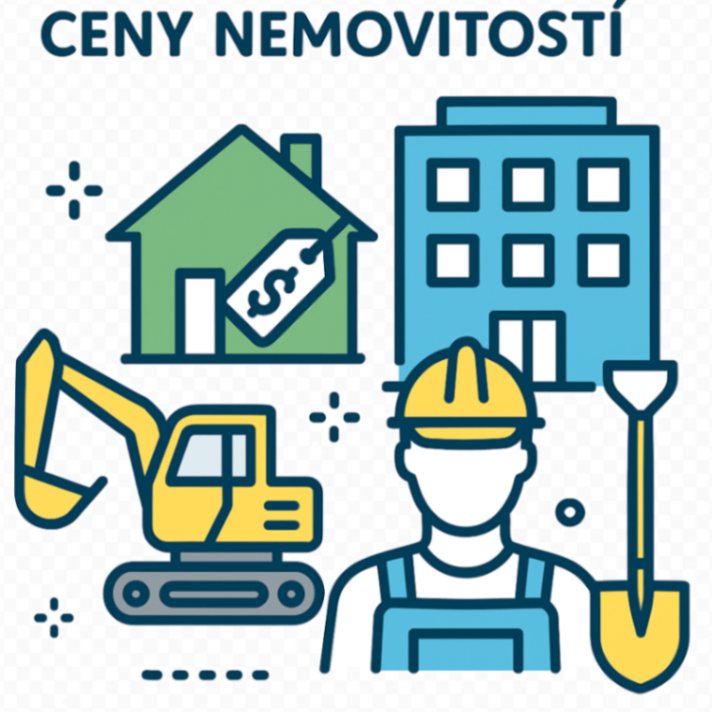"Complete" real estate prices according to the CZSO show for Q1-2025 a more moderate increase than housing prices + insight and challenge to the methodological kitchen
Economic commentary by Jaromir Šindel, Chief Economist of the CBA

According to the CSO, property prices rose 10% year-on-year in Q1 2025 after adding 2.4% in the quarter. This increase is more moderate than for house prices, as the so-called house price index includes land. We add a bit of methodology in the article where I point out the limitations of this "comprehensive" house price index (new only in Prague and surrounding areas) in the context of existing transaction price statistics. I believe and hope that there is room to move forward with the official statistics. As usual, a graphic is attached for comparison with other indicators such as incomes, etc., including insight into the CSO's methodology for house prices in Chart 7 below.
According to CSO statistics, prices for home purchases rose 10% year-over-year in Q1 2025, following a 5% increase in 2024. In Q1 alone, prices rose 2.4% quarter-over-quarter, which is essentially equal to the average pace of the previous three quarters (so 4 x 2.4 = 10%).This is, however, a more modest increase than shown by house prices in Q1-2025 (see Commentary: Strong house price growth continued with rising transactions in Q1 ...; or see Graphs 1 and 2 below).
The 10% increase relates to the so-called house price index, which is more internationally comparable and includes realised prices of older dwellings and new dwellings including land, but new only in Prague and the surrounding area (for the rest of the country see our statistics on the CBA Transaction Price Monitor from Flat Zone). That's why the quotation marks at the beginning of the word complete. To give an overview, I provide my extracts from the CSO methodology to help me disentangle the CSO data for real estate (see Chart 7).
Hopefully - given the desire to work with proper data - in time those quotation marks can be removed. For example, the Flat Zone statistics list an identifiable 4,735 first-sale condo transactions in Q1-2025; of these, 2,256 are in Prague, 515 in the Central Bohemian Region, 1,269 in regional cities, and 695 in the rest of the country. In the percentage distribution of the last two years, 47% is accounted for by Prague, 12% by the Central Bohemian Region, 26% by the remaining regional cities and 15% by the rest of the country (see last charts 8 and 9). I admit I am not an expert to determine whether these numbers are sufficient to create price indices of comparable properties (i.e. removing qualitative differences in properties for their different price), but I believe in space and see the need to move forward in this area.
The CSO also publishes an index of the cost of owner-occupied properties, where it tracks both the price of the property and the repair, maintenance and self-build of the property. That is, if you add in some of that scrap brick, fix the plaster etc yourself. This is the so-called owner-occupied housing index, which, according to CSO statistics, has increased by 4.3% year-on-year over the last four quarters. It added 1.5% quarter-on-quarter, more than the average 0.9% in the previous three quarters.
In a longer fifteen-year comparison, the increase in the cost of acquisition, including self-builds and repairs (the owner-occupied housing index), accounted for 48% of the increase in the house price index. The house price index - HPI - has jumped 12.2% over the past three years, and 58.1% over the past five years. Over the last decade, it has jumped 140%, or 148% over the last 15 years. This has outpaced the 40% and 91% growth in average disposable income over the last five and ten years respectively (for more on disposable income, see the commentary: GDP revision: growth this year is heading above 2% (...) due to stronger consumption with higher savings rates). The cost of owner-occupied property has risen by 11.2% over the last three years, and 35.4% over the last five years. Over the last decade, it has increased by 65% or 76% over the last 15 years. For comparisons with other indicators, see Charts 3-6.
Source: CZSO, CBA. | Source: CZSO, CBA